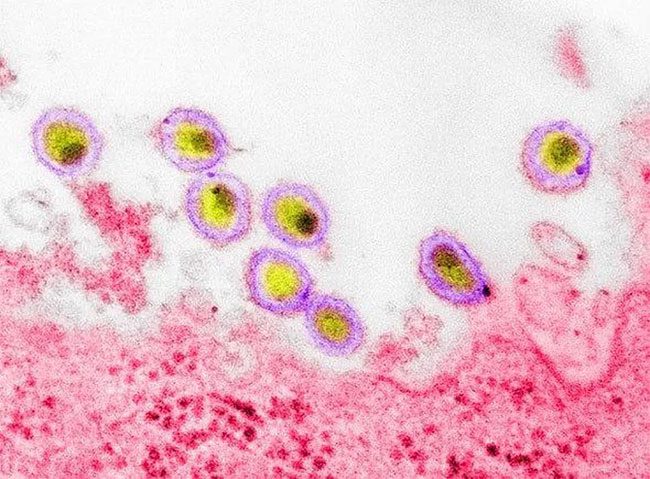According to scientists, a more virulent strain of HIV could serve as a warning for the future of COVID-19, suggesting the emergence of more concerning variants ahead.
As SARS-CoV-2 spreads across the globe, many observers have noted that HIV has been silently evolving in a different manner. In early February, a team of experts at the University of Oxford, UK, discovered that a new, highly virulent strain of HIV had been “lurking” in the Netherlands for decades.
The new HIV variant has been named VB and contains over 500 mutations scattered throughout its genome. Patients infected with the VB variant have HIV viral loads in their blood that are 3.5 to 5.5 times higher than those infected with other strains. Their immune systems also deteriorate rapidly.
Notably, if left untreated, individuals carrying the VB strain of HIV can develop AIDS just 2-3 years after diagnosis. This is significantly faster than the average 6-7 years for other HIV strains.
However, it is remarkable that after treatment, their immune systems can recover and survive similarly to those infected with other HIV strains.
The emergence of this new HIV variant is believed to potentially hold warnings for COVID-19. It suggests that the virus may not evolve into a milder strain as many have predicted.
A Worst-Case Scenario?
In an interview with Scientific American, infectious disease researcher William A. Haseltine, Chair of the Department of Cancer Research and HIV/AIDS at Harvard University, stated that viruses have the ability to adapt. Their adaptation process is similar to how we use artificial intelligence to solve complex problems. A multitude of random combinations are introduced, and the genetic sequences that survive become the dominant mutations.
With HIV, its evolutionary process is lengthy and challenging due to its low transmission rate. This process occurs more slowly because of relatively long replication cycles.

HIV-1 was identified nearly 40 years ago. In early February, researchers discovered a more harmful variant of this virus. (Image: Cultura Creative Ltd/ Alamy).
However, with Omicron, these cycles can take only hours, or at most a few days. SARS-CoV-2 can be transmitted from one person to another simply by inhaling air containing the virus.
Over the past year, the frequency of SARS-CoV-2 producing concerning variants has increased significantly. Mr. Haseltine noted that based on observations, the virulence of SARS-CoV-2 has remained quite stable, except for Delta, which has a hospitalization rate for infected individuals that is double.
This expert emphasized that Delta serves as a warning sign right in front of humanity, indicating that SARS-CoV-2 could become more transmissible and harmful.
“As long as we remain unclear about the factors determining the virulence of the virus, we cannot know whether the next variant will be more dangerous or weaker. Therefore, policymakers may be optimistic but need to prepare for the worst-case scenarios,” said Professor William.
New Variants Will Spread Faster
The Chair of Cancer Research and HIV/AIDS at Harvard University noted that RNA viruses like HIV and SARS-CoV-2 are very prone to mutations. When they jump from one person to another, they accumulate many errors, creating more opportunities for evolution compared to DNA viruses.
Human cells have a complex machinery to correct mistakes in DNA, but it faces more challenges with RNA. SARS-CoV-2 has proofreading enzymes that can correct errors in its genetic sequence, protecting it from mutations.
However, this is not entirely accurate, and Professor William warns that our greatest mistake is underestimating RNA viruses and failing to anticipate the extent to which they can change.
The selective pressure on viruses is to survive, just like any other organism. What viruses like HIV and SARS-CoV-2 aim to do is to infect from one person to another, or in other words, enter and exit host bodies.
HIV is poorly transmitted, and we can predict its infectious behavior. However, with SARS-CoV-2, the situation is not that simple. It is one of many coronavirus strains, four of which are familiar, causing endemic diseases like seasonal flu and the common cold.
Professor William stated: “We are battling millions of years of evolution of an organism that knows how to deceive the immune system. They have invaded the human body time and time again. The most obvious thing we observe is that new variants will spread faster and faster.”
This expert noted that reality has shown that Delta spreads faster than Alpha, and now Omicron continues to spread faster than Delta. Within Omicron, the subvariant BA.2 spreads faster than BA.1.
There are many ways for this virus to mutate and increase its transmissibility. According to Mr. William, which of these factors affects the virulence of the virus is a question we are yet to answer. He warns that new variants of SARS-CoV-2 could emerge with transmissibility as fast as Omicron and lethality levels comparable to Delta.

















































